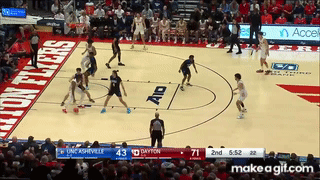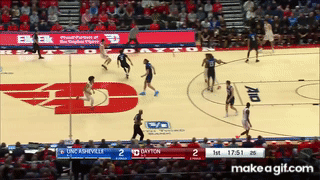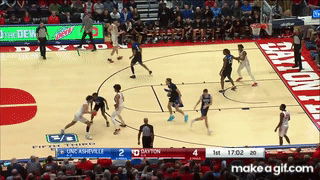Unlike last year, Arkansas has managed to navigate to the close of the non-schedule without stepping on a landmine. With conference play looming, the Hogs are hoping to close out strong before the start of conference play.
The Razorbacks’ opponent – UNC Asheville – has an absolutely horrible matchup in this game. The Razorbacks have faced several teams so far that are built to challenge them, but the Bulldogs are not one of those teams. Unless the Hogs completely don’t show up, this game figures to be one of the more lopsided games we’ve seen from the Hogs this year.
Before we preview the matchup, let’s talk advanced stats.
Searching for a single number
One of the big objectives of advanced stats is to boil all of a player’s stats down to a single number. Actually doing this is easier said than done. There are a lot of advanced stats out there, and some are clearly better than others.
All individual single stats fall into one of three groups:
- Pure box score stats, like ESPN’s PER, take box score inputs and spit out a single number.
- Statistical plus minus stats, like the BPM we mostly use here on the site, take box score stats as inputs too, but these stats are combined with weights known as Bayesian priors that are derived from plus minus data. The goal is to use box score stats to approximate how much better a player makes his team.
- Pure plus minus stats don’t use box score inputs at all. They are entirely built around points scored and allowed by the team while a single player is on the floor.
Because pure box score stats don’t use plus minus, they are not good approximators for how much better a player makes his team. After all, the goal is to outscore the opponent, not stuff the stat sheet. Isaiah Joe briefly led the NBA in PER earlier this season after he had one good game, and the stat has been criticized for rewarding high-volume players, even if they don’t make their team better.
Statistical plus minus models are better. The weights derived from plus minus data tell us how valuable each stat is. But using box score stats as inputs can cause issues the same issues as above, because not every contribution a player makes shows up in the box score. Good help defense, altering a shot, making a great pass to start a fast break, deflecting a pass out of bounds… all of those things are positive contributions that are non-statistical, so BPM cannot capture them. BPM tends to be correlated to height, since two of the three major defensive box score stats – defensive rebounds, blocks, and steals – are usually associated with taller players. Connor Vanover led Arkansas in BPM in both 2021 and 2022, while Makhi Mitchell leads the Hogs this season. Are they actually the best players on those teams? No, not even close. Vanover routinely got beat on defense and was a liability because he couldn’t switch. That doesn’t show up in the box score, but his blocks and defensive rebounds do. Mitchell also snags a ton of defensive rebounds, and he shoots a high percentage largely because his teammates create good shots for him.
At Fayette Villains, we’ve used a “player grade” that is basically just BPM with an added plus minus adjustment that I designed myself to try and account for issues in BPM. My method is not broadly acceptable statistically for several technical reasons. The raw plus minus adjustment is not the best way to use plus minus, as we discuss below. It’s also taking about four hours to compute the adjustment on my computer, since it has to go through every single possession by every single player in the country, one by one. By season’s end, it will take about 14 hours to run, which makes next-day recaps harder to write.
So though I want to keep using BPM, I wanted to get more accurate. That means we need to properly utilize plus minus data.
Regularized Adjusted Plus Minus (RAPM)
Raw plus minus data has been around for a while. We post it on our game recaps, and it certainly is relevant. It simply takes the change in score while a player is on the floor. So if Player A enters the game when his team is up 24-22 and leaves when his team is up 30-25, then he gets +3 for that stint on the court, because his team expanded its lead from two points to five points.
But while raw plus minus is useful for small-sample recaps (like a single game), it does not have much predictive power (will a player with a good plus minus in his last game continue to have a good plus minus moving forward?), because it is full of confounding variables. Maybe Player A has a good plus minus because he’s normally on the floor with Player B, who is the team’s best player. Last season, Kamani Johnson had a terrible plus minus because he usually subbed in for Jaylin Williams, while Devo Davis – who almost never subbed in for Williams or JD Notae – had a great plus minus because he was usually sharing the floor with those two. So Devo’s higher plus minus is not directly the result of his own contributions, but rather, there are other factors at play. This is known as collinearity: when several different variables all influence an outcome, it is very difficult to isolate the influence of a single variable.
We have many statistical ways to deal with collinearity. The best option is a regression. A regression can remove outliers – Players A and B check in together, Player B suddenly gets hot from 3, so Player A’s plus minus looks really good even though he didn’t do anything – and tell us whether or not a team generally gets better when that player enters the game. If Player B gets hot from 3 every time Player A checks in, then maybe Player A is causing that. But if that only happens a few times, then it’s probably a coincidence, and thus an outlier that regression will deal with. A simple linear regression creates a stat called Adjusted Plus Minus (APM), which tells us how much better a team usually becomes when that player checks in.
APM is a major upgrade, but it still does not fully deal with collinearity. It only removes outliers, but teams typically have established lineup patterns (as above, Devo almost always was on the floor with both Notae and Williams last season), so a simple regression isn’t strong enough. That’s why we need a stronger regression: a ridge regression. I’ll let Wikipedia explain:
Ridge regression is a method of estimating the coefficients of multiple-regression models in scenarios where the independent variables are highly correlated.
“Highly correlated” being key here, ridge regression includes a regularization factor, usually known as lambda, that attempts to mitigate the impact of multicollinearity. At lambda = 0, there is no multicollinearity, and the output is just a simple regression. At lambda = infinity, then there is total multicollinearity, so the output is the same for every variable (all players have the same plus minus). The “true” lambda is somewhere in between and can be calculated by testing which lambda finds the lowest amount of correlation between different input variables.
The output of this ridge regression is known as Regularized Adjusted Plus Minus, or RAPM. RAPM is the basis for the weights created for BPM, so BPM is just an attempt to use box score stats to approximate RAPM. RAPM tells us how much a player contributes to his team, independent of all other players on the floor, making it the gold standard of descriptive individual advanced stats.
Here are Arkansas’ top players by RAPM:
- Ricky Council IV +6.9
- Jordan Walsh +6.8
- Anthony Black +6.8
The actual RAPM number is not relevant. Walsh doesn’t actually make Arkansas 6.8 points better per 100 possessions… that number is the output of a regression relative to lambda, so it’s only useful to compare players to other players. That’s why on the site, you won’t see the output of the model, instead, you’ll see the number normalized to a value of 0-100. So an RAPM of 96 means that player’s RAPM is in the 96th percentile of all players in Division I this season.
RAPM does have a major downside: it requires absolutely massive samples to be truly accurate. In the NBA – which is where this stat is normally used, I’m not aware of anyone else attempting to apply it to college hoops – it is generally recommended to use RAPM over multiple seasons, or 150+ 48-minute NBA games. We’re dealing with a sample of about 11 40-minute games per team. Not even close.
As the season goes on, it will get much more accurate. But for now, Council, Walsh, and Black have a large lead over the rest of the team, and rank 12th, 13th, and 16th in Division I right now. The worst player is interesting: Trevon Brazile. The sample size plays a role there: Brazile’s top minutes games were San Diego State (40) and Creighton (32), games where the team was a combined +1. He didn’t play nearly as often in more lopsided games. But San Diego State and Creighton were really good, so that’s not really Brazile’s fault that he was counted on more in close games. As conference play begins, we’ll start getting more accurate numbers because the quality of competition will be higher and more even.
Moving forward, we will use RAPM in our previews. We’ll also use Value Over Replacement Player (VORP), which is basically the total box score contribution: a possession-weighted version of BPM (as opposed to regular BPM, which sets everything to per 100 possessions). That tells how much was measurably contributed in the box score. You’ll see VORP as the first number in both recaps (for single game) and previews (for all-season).
Hopefully this is useful for understanding what those numbers mean going forward.
Meet the Bulldogs
Located deep in the Smokey Mountains on I-40 between Charlotte and Knoxville, UNC Asheville is a small undergraduate school that, typical of schools in North Carolina, places a big emphasis on basketball. The Bulldogs have reached four NCAA Tournaments since 2003, all of them as 15 or 16 seeds. In the last 11 years, they’ve made three NCAA Tournaments, one NIT, and one CBI.
UNC Asheville is coached by Mike Morrell, who is in his fifth season. Morrell was an assistant at Texas under Shaka Smart, and lots of Smart’s influence can be seen in UNCA’s fast pace.

Picked to finish third in the 10-team Big South, the Bulldogs are off to an 8-4 start (6-4 against Division I teams). Their best win was a double-overtime road win over the same UCF team that beat Ole Miss and that Mizzou needed a buzzer-beater to defeat.

Model pick: Arkansas 89, UNC Asheville 63. The Bulldogs play fast and don’t play much defense. Get ready to run!
When UNC Asheville has the ball

The Bulldogs can put some points up, and they’ll do it in a unique way. They’ll play fast and look for 3-pointers in transition. The Hogs did a nice job of shutting down Bradley, who wanted to do the same.
There’s only one real name to know: Drew Pember. The 6’11 center is averaging 19.7 points and 9.5 rebounds per game. Almost 60% of his points this season have come from either beyond the arc (where he shoots an excellent 42%) or at the free throw line (where he’s an 84% foul shooter averaging almost eight attempts per game). He’s also second on the team in assists, third in steals, and blocks a whopping 2.9 shots per game. This dude does everything. His 31% usage is easily the highest of any forward the Hogs have faced so far this season.
Because Pember has to be defended on the perimeter due to his jump shooting, I’m curious to see how the Hogs defend him. It would be nice to have Trevon Brazile, but alas, we’re probably going to get a look at Makhi Mitchell’s ability to defend on the perimeter. We could also see some kind of backside helper defense where the Hogs try to keep Mitchell in the post but have him rotate over when the ball advances inside the arc.
Pember’s usage is so high that only one other Bulldog is considered high-usage: 6’8 power forward Nick McMullen, who grades as the team’s leader in RAPM. The Murray State transfer does all of his damage near the rim, taking advantage of Pember drawing opposing bigs out of the paint. The Hogs have to like Jordan Walsh matching up with him.
The main scoring guard is 6’5 Taijon Jones, who is a lethal 3-point shooter, shooting 48% on high volume this year. He leads the Bulldogs in offensive rating (122.7) and effective field goal percentage (68%). He’s also a pretty good defender, per DRAPM, and grades out as the Bulldogs’ second-best overall player behind Pember.
Senior 6’5 small forward Jamon Battle is coming off his best game of the season, scoring 21 points against East Tennessee State. He does a little bit of everything on offense, shooting 60% inside the arc, getting to the free throw line, and crashing the offensive glass. He grades as the team’s weakest defender. Point guard has been a problem, with 6’3 Fletcher Abee, 6’2 Trent Stephney, and 6’3 Caleb Burgess all playing, though none very effectively. Abee is more of a distributor who doesn’t turn it over, but he’s a defensive liability and is limited as a scorer. He also hasn’t played in the last two games and I’m not sure why. Stephney has the most upside as he’s the best individual defender, but he’s a bit turnover-prone and, like Abee, not much of a scorer. Burgess’ numbers are rough – he grades as one of the worst players in the country – and he does not really do anything well.

Asheville wants to get the ball inside, but the 3-point shot is where they do the most damage. Pember will take 3-pointers if you don’t defend them out on the perimeter, and his presence draws defenders away from other shooters. The Bulldogs’ main issue is that they don’t create enough shots for themselves: they turn it over like crazy, are below-average on the offensive glass, and are only decent at getting to the free throw line.
Even if the Bulldogs get hot from beyond the arc, the Hogs should be able to smother the perimeter and limit their chances. The only real concern would be if Pember also goes crazy inside and the Hogs get inside-outed to death.
When Arkansas has the ball

The Bulldogs are going to need to score some points, because we could see a bloodbath on this side of the ball. Asheville’s defense is bad anyway, but this is a particularly heinous matchup for them.

Well, we’re about to find out what happens when one of the nation’s best teams at attacking the rim faces one of the nation’s worst teams at defending it.
Asheville’s defense is weird. You’d think they would park their 6’11 center under the basket to protect the rim… but they don’t. Pember isn’t a very bulky player and he would not do well in a post-up, so instead they have him defend out on the perimeter and try to set him to block shots as a help defender.
To be fair, he can sometimes use his length to make something happen, like on this impressive play:

But if he can’t help, the Bulldogs have no one capable of stopping tall, driving guards from just going straight to the rim:

You don’t really even need a good driver to break down Asheville’s defense. Just get Pember on the perimeter and advance the ball past him, and there’s not much UNCA can do:

If Asheville could actually force turnovers like a proper press defense, then they could probably mitigate some of the effects of this weakness. But they don’t force turnovers at all: their Shaka Smart-influenced full court man-to-man is basically just an escort up the floor for the ballhandler. So the Hogs will get plenty of chances to get the ball in the basket, meaning that even a bad shooting day wouldn’t be a huge concern.
Personnel

Keys to the Game
- Play loose. Asheville needs to go fast to have a chance on offense, but they’re walking (or running, rather) into a buzzsaw by trying to play fast without defending the rim. If the Hogs stay aggressive and well-spaced, they should have no issues scoring almost at will.
- Tighten up on the perimeter. UNCA will do most of its damage from beyond the arc, where they have several capable shooters. Arkansas did very well on the perimeter against Bradley, where their long guards could take away open looks. A repeat performance would be good.
Thanks for reading! Be sure to follow us on Twitter.
The latest from Fayette Villains, straight to your inbox
Enter your email to subscribe and receive new post alerts and other updates. You can unsubscribe at any time.